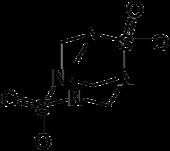Abbreviations TETS, DSTA Molar mass 240.26 g/mol Appearance White powder | Formula C4H8N4O4S2 | |
 | ||
Tetramethylenedisulfotetramine (TETS) is an organic compound that is used as a rodenticide (rat poison). It is an odorless, tasteless white powder that is slightly soluble in water, DMSO and acetone, and insoluble in methanol and ethanol. It is a sulfamide derivative. When crystallized from acetone, it forms cubic crystals with a melting point of 255–260 °C.
Contents
Toxicity and mechanism
TETS is a neurotoxin, causing lethal convulsions. Its effect is similar to but stronger than picrotoxin, a GABA-A receptor antagonist widely used in research. As one of the most hazardous pesticides, it is 100 times more toxic than potassium cyanide. TETS is an suicide inhibitor that binds irreversibly to neuronal GABA gated chloride channels, often causing status epilepticus. No antidote is known. The lethal dose for humans is 7–10 mg. Poisoning is diagnosed by GC-MS and the treatment is mainly supportive, with large doses of IV clonazepam and pyridoxine to control symptoms. TETS is sequestered in tissues of poisoned birds and can thus pose severe risk of secondary poisoning.
Continued use in China
Its use worldwide has been banned since 1984, but due to continuing demand and its ease of production, it is still readily, although illegally, available in China and can be found in some illegally imported rat poisons. The best known Chinese rodenticide, containing about 6–20% TETS, is Dushuqiang, "very strong rat poison". It has been used for mass poisonings in China: in April 2004, there were 74 casualties after eating scallion-flavored pancakes tainted by their vendor's competitor; and in September 2002, 400 people were poisoned and 38 died from contaminated food. In 2002, there was one documented case of accidental poisoning in the US.
